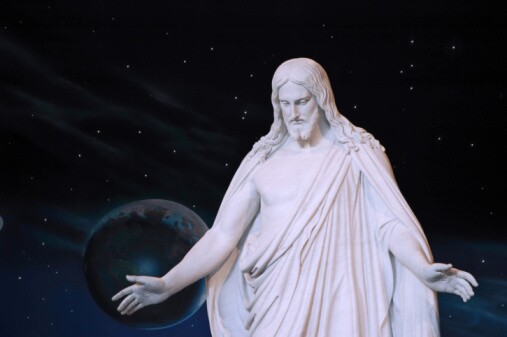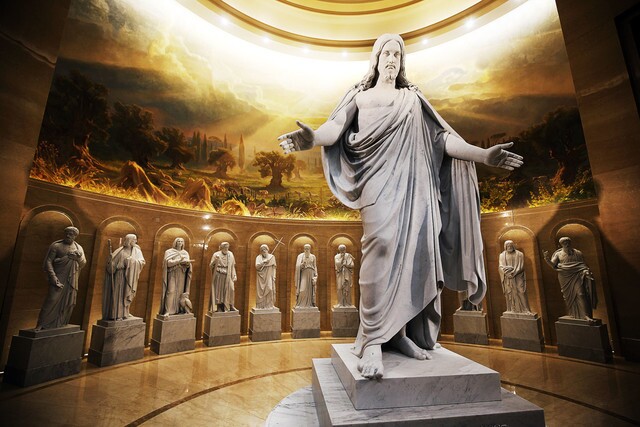Editor's note: This adaptation from Matthew O. Richardson's The Christus Legacy originally ran on LDS Living in 2015. During April 2020 general conference, President Nelson introduced the Church's new symbol, which includes a representation of Thorvaldsen’s marble statue, the Christus. This iconic representation of the Savior is well-known to Latter-day Saints, but it wasn’t always that way. Check out how this statue came about and how it eventually earned its fame in the Latter-day Saint world.
1. There are five known sketches/models of the Christus: three plaster models and two pencil drawings.
The inspiration for Bertel Thorvaldsen's Christus statue is unknown and could have come from his study of classical Greek sculptures, especially the work of Raphael. There are other potential inspirations, but because Thorvaldsen rarely kept drawings or models, we shall probably never know the precise evolution of the statue.
All five models are in Thorvaldsen's Museum in Copenhagen, Denmark.
2. Early sketches and models of the Christus show the arms of Christ raised above His head.
There are several theories of how the statue ended up with the lower extended arms it has today:
- According to J.M. Thiele, Thorvaldsen's biographer, Herman Ernst Freund listened to Thorvaldsen's complaints with his arms crossed upon his chest and questioned what Thorvaldsen wanted to communicate with the position of Christ's arms. As Thorvaldsen contemplated an answer, he suddenly exclaimed, "I have it now! It shall be so!" Thus, according to Thiele, the conception of the Christus was nothing short of divine inspiration.
- Another version claims that while Freund, standing with arms folded across his chest, was listening sympathetically to the discouraged Thorvaldsen, he tried to cheer him up, unfolded his arms, and half-opened them, dropping them slightly downward, palms upward. Thorvaldsen saw his friend pose the posture he desired for his statue of Christ and quickly sketched the idea in his notes.
- One last version of how the arms of Christ came to be positioned deals with one of Thorvaldsen's early clay models. In this version, the raised arms slumped during the night from the higher position above Christ's head to His waist. Thorvaldsen, upon seeing this new pose, quickly made it permanent.
3. Both President Spencer W. Kimball and Elder Stephen L. Richards called the statue and its creator "inspired."

President Spencer W. Kimball, after viewing the Christus and Thorvaldsen's Twelve Apostles in the Church of Our Lady, stated that "the man who created these statues was surely inspired of the Lord."
On another occasion in September 1950, Elder Richards (then a member of the Sunday School general superintendency) and his wife Irene visited the Church of Our Lady while in Copenhagen. According to Philip Richards, Elder and Sister Richards's son, while his parents were in the Danish cathedral, they had an "awe-inspiring experience" while gazing at the Christus and "the idea was planted in his father's mind that a copy of this statue needed to be on Temple Square." It would be a few more years until that inspiration would unfold in reality.
The opportunity came in the 1950s, when the Temple Square Presidency was assigned to find ways to improve missionary work at the historic site. The plans to build a new center were approved by the First Presidency in 1955.
Around this same time, plans were brainstormed to provide visitors with a guided tour of the grounds. According to George Cannon Young, it was in a planning meeting that Elder Richard L. Evans, then President of the Temple Square Presidency and member of the Quorum of the Twelve Apostles, commented, "You know, the world thinks we're not Christians because they see no evidence of Christ on this square. They hear the words, but see no evidence."
As the group discussed possible images that would meet their criteria of having a representation of Christ that would "make an impact upon the world—one that would be world-known and be received without creating controversy," Marion D. Hanks suggested using a marble copy of Bertel Thorvaldsen's Christus.
4. Stephen L. Richards had a personal copy of the original statue made and then donated it to the Church.
On June 7, 1957, the Church Building Committee met with the First Presidency to present their proposal to use a marble copy of Thorvaldsen’s statue on Temple Square. Even though the Temple Square Presidency felt certain that a heroic-sized statue of Christ should be placed on the Square, they were nervous how the First Presidency might react to such a proposal. After all, statuary of Christ had never been a part of traditional Latter-day Saint worship.
At the hesitancy of the rest of the committee to describe their proposal, Temple Square President Stephen L. Richards announced that the building plans included a spot for the Christus. Apparently, Richards and President McKay had already discussed the plan, because President McKay then turned to him and asked, "Don't you have access to acquire a statue through your association with Hubert Eaton and Forest Lawn?"
President Richards was asked to determine the feasibility of obtaining a copy of the Christus. He immediately contacted his friend, Hubert Eaton, to see if he might make a copy of one of the Christus statues on display at Forest Lawn. Richards decided to make the statue a personal and anonymous donation to the Church, so he took care of all of the preliminary work himself. The statue was sent to Italy and a marble replica was made.
The finished statue ordered by Richards was 11 feet 1/4 inch and weighs close to 12,000 pounds. Shockingly, President Richards became gravely ill and passed away just days before the finished statue arrived in Salt Lake City. Sadly, he never saw the statue that he hoped would become a legacy to the Church.
5. The Temple Square Christus was almost displayed outside.
The original plans at Temple Square included an outside viewing area for the Christus to stand. But members of the Building Committee expressed their concern of the figure being exposed to the harsh mountain climate in Salt Lake City. This sparked the idea of a home for the Christus. The Christus was to be displayed in a glass rotunda in the Bureau of Information building, which later became the North Visitors’ Center. It was to be the focal point of the building, and of the entire site. During construction, because of the enormity of the Christus, builders had to lower the statue into the structure and construct around it.
The final presentation of the awe-inspiring statue took many years, and after a spiral ramp was finished, mural painted, and light fixtures added, the Christus was open for public viewing in 1967. Today there are 14 statues used in displays by the Church at the Temple Visitors' Centers in Salt Lake City, Los Angeles, New Zealand, Hawaii, Arizona, Washington D.C., Mexico City, Nauvoo, Oakland, St. George, Utah; Palmyra, New York; Hill Cumorah; Independence, Missouri; and a traveling statue, plus one statue donated to the Icelandic Immigration Museum in Reykjavik, Iceland.
Note: Since this book was published in 2007, other Christus statues have been added to the following temple sites: Idaho Falls Idaho, London England, Paris France, Portland Oregon, Provo City Center, Rome Italy, and São Paulo Brazil. During the Salt Lake Temple Renovation, there is also a Christus statue at the Conference Center.

